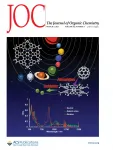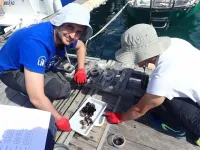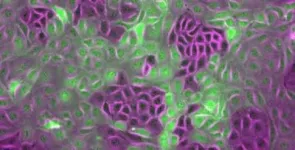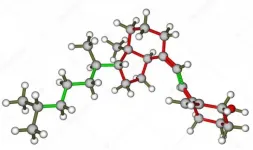Muscle gene linked to type 2 diabetes
2021-04-23
(Press-News.org) People with type 2 diabetes tend to have poorer muscle function than others. Now a research team at Lund University in Sweden has discovered that in type 2 diabetes, a specific gene is of great importance for the ability of muscle stem cells to create new mature muscle cells. The findings are published in Nature Communications.
"In people with type 2 diabetes, the VPS39 gene is significantly less active in the muscle cells than it is in other people, and the stem cells with less activity of the gene do not form new muscle cells to the same degree. The gene is important when muscle cells absorb sugar from blood and build new muscle. Our study is the first ever to link this gene to type 2 diabetes", says Charlotte Ling, professor of epigenetics at Lund University who led the study.
In type 2 diabetes, the ability to produce insulin is impaired, and patients have chronically elevated blood sugar. Muscles are generally worse at absorbing sugar from food, and muscle function and strength are impaired in patients with type 2 diabetes.
A muscle consists of a mixture of fiber types with different properties. Throughout life, muscle tissue has the ability to form new muscle fibers. There are also immature muscle stem cells that are activated in connection with, for example, injury or exercise. In the current study, the researchers wanted to investigate whether epigenetic patterns in muscle stem cells can provide answers to why impaired muscle function occurs in type 2 diabetes.
Two groups were included in the study: 14 participants with type 2 diabetes and 14 healthy people in a control group. The participants in the groups were matched by age, gender and BMI (body mass index). The researchers studied epigenetic changes in the muscle stem cells in both groups, and under exactly the same conditions, they also extracted mature muscle cells and compared them. In total, they identified 20 genes , including VPS39, whose gene expression differed between the groups in both immature muscle stem cells and mature muscle cells. The researchers also compared the epigenetic patterns of muscle cells before and after cell differentiation in both groups.
"Despite the fact that both groups' muscle stem cells were grown under identical conditions, we saw more than twice as many epigenetic changes in the type 2 diabetes group during the differentiation from muscle stem cell to mature muscle cells. Muscle-specific genes were not regulated normally, and epigenetics did not function in the same way in cells from people with type 2 diabetes", says Charlotte Ling.
"The study clearly showed that muscle stem cells that lack the function of the gene VPS39, which is lower in type 2 diabetes, also lack the ability to form new mature muscle cells. This is because muscle stem cells that lack VPS39 due to altered epigenetic mechanisms cannot change their metabolism in the same way as muscle stem cells from controls - the cells therefore remain immature or break down and die", says Johanna Säll Sernevi, postdoc researcher at Lund University.
To confirm the findings, the researchers also used animal models with mice that had a reduced amount of the VPS39 gene, to mimic the disease. The mice subsequently had altered gene expression and reduced uptake of sugar from blood into the muscle tissue, just like the individuals with type 2 diabetes.
The comprehensive study is a collaboration between Swedish, Danish and German researchers, who believe that the findings open up new avenues for treating type 2 diabetes.
"The genome, our DNA, cannot be changed, although epigenetics in effect does. With this new knowledge, it is possible to change the dysfunctional epigenetics that occur in type 2 diabetes. For example, by regulating proteins, stimulating or increasing the amount of the VPS39 gene, it would be possible to affect the muscles' ability to regenerate and absorb sugar", concludes Charlotte Ling.
INFORMATION:
ELSE PRESS RELEASES FROM THIS DATE:
2021-04-23
Recently study on synthetic approaches toward polycyclic aromatic hydrocarbons (PAHs) as graphene with a well-defined structure has attracted much attention. A research group in Ehime University has been studying the synthesis and fundamental properties of pyrrole-fused azacoronene (HPHAC), a nitrogen-containing PAH. HPHACs are composed of electron-rich pyrroles, which are easily oxidized, and their dicationic species in particular exhibit unique features such as global aromaticity based on macrocyclic π-conjugation. However, all the compounds reported so far have bulky ...
2021-04-23
An interdisciplinary group of Spanish scientists, bringing together biologists and chemists from the Universities of Seville, Huelva, the Autonomous University of Madrid and the Institute of Marine Sciences of Andalusia of the CSIC in Cadiz, have just published the results of their pioneering research studying the management of marinas. The group of scientists, led by the US professor José Manuel Guerra García, studied in detail the sediments in Andalusia's marinas and has proposed a new index, the MEPI (Marinas Environmental Pollution Index) to quantify the level of contamination in these ports.
There has been a proliferation of marinas in recent ...
2021-04-23
The giant star featured in this latest Hubble Space Telescope anniversary image is waging a tug-of-war between gravity and radiation to avoid self-destruction. The star, called AG Carinae, is surrounded by an expanding shell of gas and dust -- a nebula -- that is shaped by the powerful winds of the star. The nebula is about five light-years wide, which equals the distance from here to our nearest star, Alpha Centauri.
The huge structure was created from one or more giant eruptions several thousand years ago. The star's outer layers were blown into space, the expelled material ...
2021-04-23
How do the billions of cells communicate in order to perform tasks? The cells exert force on their environment through movement - and in doing so, they communicate. They work as a group in order to infiltrate their environment, perform wound healing and the like. They sense the stiffness or softness of their surroundings and this helps them connect and organize their collective effort. But when the connection between cells is distrubeddisturbed, a situation just like when cancer is initiated, can appear.
Assistant Professor Amin Doostmohammadi at the Niels Bohr Institute, University of Copenhagen has investigated the mechanics of cell movement and connection ...
2021-04-23
Etrasimod 2 mg treatment group achieved statistical significance in the percentage change in weekly peak pruritis (PP-NRS), in the change in Dermatology Life Quality Index (DLQI), and in the change in Patient-Oriented Eczema Measure (POEM)
Etrasimod 2 mg was generally well tolerated, consistent with data in previous trials
Park City, Utah, April 23, 2021 - Arena Pharmaceuticals, Inc. (Nasdaq: ARNA) today announced data at a late-breaking session at the American Academy of Dermatology VMX Experience. Etrasimod, a novel investigational drug candidate to treat moderate-to-severe atopic dermatitis (AD), demonstrated statistical significance in both clinician and patient reported outcomes in the ADVISE Phase 2b clinical trial. Etrasimod is a highly selective, once-daily, oral sphingosine ...
2021-04-23
Paper Title: Safety of Tranexamic Acid in Hip and Knee Arthroplasty in High-risk Patients
Journal: Anesthesiology
Authors: Jashvant Poeran MD, PhD, Director of the Center for Clinical and Outcomes Research, and Associate Professor of Population Health Science & Policy and Orthopedics at the Icahn School of Medicine at Mount Sinai; Calin S. Moucha, MD, Chief of Adult Reconstruction & Joint Replacement Surgery at Mount Sinai Hospital, and Associate Professor of Orthopedics at the Icahn School of Medicine at Mount Sinai; and other coauthors.
Bottom Line: The use of the drug tranexamic acid is commonplace in patients undergoing hip or knee replacement surgery to reduce blood loss. However, this drug works by promoting clotting and safety concerns exist when used in certain high-risk ...
2021-04-23
By Karina Toledo | Agência FAPESP – Can a high dose of vitamin D administered on admission to hospital improve the condition of patients with moderate or severe COVID-19? The answer is no, according to a Brazilian study published in the Journal of the American Medical Association (JAMA).
The article reports a randomized, double-blind, placebo-controlled clinical trial, the kind of study considered the gold standard to evaluate drug efficacy. It was conducted with FAPESP’s support by researchers at the University of São Paulo’s ...
2021-04-23
DURHAM, N.H.-- Corals and sponges are important foundations in ocean ecosystems providing structure and habitats that shelter a high number of species like fish, crabs and other creatures, particularly in the seamounts and canyons of the deep sea. Researchers at the University of New Hampshire have discovered that when it comes to climate change not all deep-sea corals and sponges are affected the same and some could be threatened if average ocean temperatures continue to increase in the deep sea of the Northwest Atlantic.
"These deep-sea corals and sponges are ecologically important because they are foundational ...
2021-04-23
ITHACA, N.Y. - House finches are locked in a deadly cycle of immunity and new strains of bacterial infection in battling an eye disease that halved their population when it first emerged 25 years ago, according to new research from the Cornell Lab of Ornithology.
House finch eye disease causes red, swollen, watery or crusty eyes. Afflicted birds can recover, but may die because they cannot see well enough to find food or avoid predators. The latest analyses, based on the observations of Project FeederWatch participants from eight Northeast states, addresses the long-term ...
2021-04-23
A recently published article in the Molecular Plant-Microbe Interactions journal provides new evidence that pathogens are hijacking the plant immune system to cause disease while providing insights into a newly discovered mechanism.
A large variety of pathogens infect plants and cause different diseases, which can lead to reduced crop yields. During infection, pathogens secrete effector proteins into the plant cell. Some of these proteins target plant proteasomal degradation machinery, which is responsible for recycling proteins to regulate cell processes. Some E1, E2 and E3-ligase proteins have been identified as playing a role in plant susceptibility ...
LAST 30 PRESS RELEASES:
[Press-News.org] Muscle gene linked to type 2 diabetes




